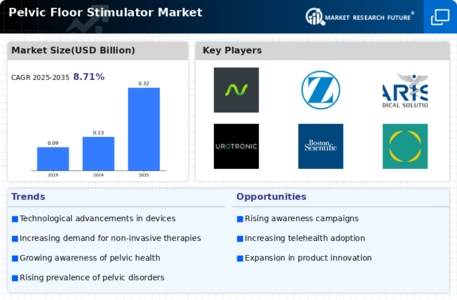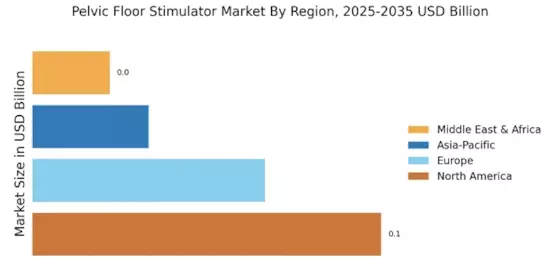Shift Towards Home Healthcare Solutions
The shift towards home healthcare solutions is reshaping the Pelvic Floor Stimulator Market. With an increasing number of patients preferring to manage their health conditions from the comfort of their homes, pelvic floor stimulators are gaining traction as convenient and effective treatment options. This trend is particularly evident among individuals with mobility issues or those who prefer privacy in their treatment. Market Research Future suggests that the home healthcare segment is projected to grow significantly, with a focus on devices that are easy to use and require minimal supervision. As a result, the Pelvic Floor Stimulator Market is likely to benefit from this shift, as manufacturers develop products tailored to meet the needs of home users.
Rising Healthcare Expenditure and Accessibility
Rising healthcare expenditure is contributing to the growth of the Pelvic Floor Stimulator Market. As healthcare systems evolve, there is a greater emphasis on preventive care and non-invasive treatment options. Pelvic floor stimulators are being recognized as effective tools for managing pelvic health issues, leading to increased investment in these devices by healthcare providers. Furthermore, improved accessibility to healthcare services is enabling more individuals to seek treatment for pelvic floor disorders. Market analysis indicates that healthcare spending is expected to rise by 5% annually, which may further bolster the Pelvic Floor Stimulator Market as more patients are able to afford and access these innovative solutions.
Aging Population and Demand for Pelvic Floor Solutions
The aging population is a significant driver of the Pelvic Floor Stimulator Market. As individuals age, they often experience various pelvic floor disorders, including urinary incontinence and pelvic organ prolapse. This demographic shift is leading to an increased demand for effective treatment options, including pelvic floor stimulators. Recent statistics suggest that nearly 25% of older adults experience some form of pelvic floor dysfunction, highlighting the urgent need for accessible solutions. The Pelvic Floor Stimulator Market is likely to expand as healthcare providers increasingly recommend these devices as part of comprehensive treatment plans for older patients, thereby addressing a critical healthcare need.
Increased Awareness and Education in Pelvic Floor Health
There is a growing awareness regarding pelvic floor health, which is significantly influencing the Pelvic Floor Stimulator Market. Educational campaigns and initiatives aimed at informing the public about pelvic floor disorders and their treatment options are becoming more common. This heightened awareness is leading to an increase in demand for pelvic floor stimulators, as individuals seek effective solutions for issues such as incontinence and pelvic pain. Market data indicates that the number of consumers seeking information on pelvic health has risen by over 30% in recent years. Consequently, the Pelvic Floor Stimulator Market is poised for growth as more individuals recognize the importance of maintaining pelvic floor health and the role stimulators can play in their treatment.
Technological Advancements in Pelvic Floor Stimulator Market
The Pelvic Floor Stimulator Market is experiencing a surge in technological advancements that enhance the efficacy and user experience of pelvic floor stimulators. Innovations such as biofeedback mechanisms and app integration are becoming increasingly prevalent, allowing users to monitor their progress in real-time. The introduction of portable and user-friendly devices has broadened the appeal of these products, making them accessible to a wider audience. According to recent data, the market is projected to grow at a compound annual growth rate of approximately 8% over the next five years, driven by these technological improvements. As manufacturers continue to invest in research and development, the Pelvic Floor Stimulator Market is likely to witness the emergence of more sophisticated devices that cater to diverse consumer needs.


















Leave a Comment